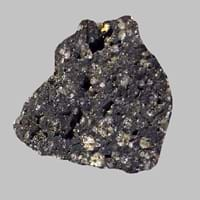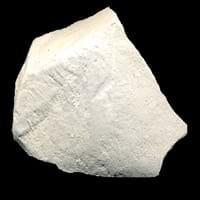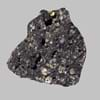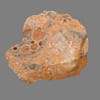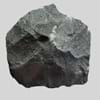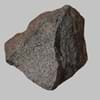Definition
Borolanite is a variety of Nepheline Syenite and belongs to igneous rocks and contains nepheline-alkali feldspar pseudomorphs which occur as conspicuous white spots in the dark rock matrix
Chalk is a soft, white, powdery limestone consisting mainly of fossil shells of foraminifers
Discoverer
Unknown
Unknown
Etymology
From Alkalic Igneous complex near Loch Borralan in northwest Scotland
From old English cealc chalk, lime, plaster; pebble, from Greek khalix small pebble, in English transferred to the opaque, white, soft limestone
Class
Igneous Rocks
Sedimentary Rocks
Sub-Class
Durable Rock, Medium Hardness Rock
Durable Rock, Soft Rock
Group
Plutonic
Not Applicable
Other Categories
Fine Grained Rock, Opaque Rock
Fine Grained Rock, Opaque Rock
Texture
Granular
Clastic or Non-Clastic
Color
Brown, Buff, Cream, Green, Grey, Pink, White
Grey, White, Yellow
Durability
Durable
Durable
Appearance
Banded and Foilated
Soft
Interior Uses
Countertops, Decorative Aggregates, Flooring, Homes, Interior Decoration
Decorative Aggregates, Homes, Interior Decoration
Exterior Uses
As Building Stone, As Facing Stone, Paving Stone, Garden Decoration, Office Buildings
As Building Stone, As Facing Stone, Paving Stone, Garden Decoration
Other Architectural Uses
Curbing
Powder
Construction Industry
As Dimension Stone, Cement Manufacture, Construction Aggregate, for Road Aggregate, Landscaping, Making natural cement, Manufacture of Magnesium and Dolomite Refractories, Production of Glass and Ceramics
As Dimension Stone, Cement Manufacture, Construction Aggregate, for Road Aggregate, Making natural cement, raw material for manufacture of quicklime and slaked lime, Source of calcium
Medical Industry
Not Yet Used
Not Yet Used
Antiquity Uses
Artifacts
Artifacts, Monuments, Sculpture, Small Figurines
Commercial Uses
Cemetery Markers
Alumina Refineries, Creating Artwork, Drawing on blackboards, Gymnasts, athletes and mountain climbers use for grip, In aquifers, Paper Industry, Production of Lime, Raw material for manufacture of quicklime, slaked lime, Soil Conditioner, Whiting, Whiting material in toothpaste, paint and paper
Types
Not Available
Not Available
Features
Application of acids on the surface causes cloudy frosting, Available in Lots of Colors and Patterns, Dissolves in hydrochloric acid, Is one of the oldest rock
Clasts are smooth to touch, Is one of the oldest rock, Smooth to touch, Very fine grained rock
Archaeological Significance
Famous Monuments
Data Not Available
Data Not Available
Famous Sculptures
Data Not Available
Data Not Available
Formation
Borolanites are formed due to alkaline igneous activities and are generally formed in thick continental crustal areas or in Cordilleran subduction zones.
Chalk is formed from lime mud, which accumulates on the sea floor which is then transformed into rock by geological processes.
Mineral Content
Albite, Amphibole, Biotite, Cancrinite, Feldspar, Hornblende, Plagioclase, Pyroxene, Sodalite
Calcite, Clay, Clay Minerals, Quartz, Sand
Compound Content
Aluminium Oxide, CaO, Iron(III) Oxide, FeO, Potassium Oxide, MgO, MnO, Sodium Oxide, Phosphorus Pentoxide, Silicon Dioxide, Titanium Dioxide
Ca, NaCl, CaO
Types of Metamorphism
Regional Metamorphism
Not Applicable
Types of Weathering
Chemical Weathering, Mechanical Weathering
Biological Weathering, Chemical Weathering
Types of Erosion
Wind Erosion
Chemical Erosion, Coastal Erosion, Water Erosion
Grain Size
Fine Grained
Very fine-grained
Fracture
Conchoidal to Uneven
Not Available
Porosity
Less Porous
Highly Porous
Luster
Greasy to Dull
Dull
Compressive Strength
Not Available
Cleavage
Poor
Non-Existent
Toughness
Not Available
1
Specific Gravity
2.6
2.3-2.4
Transparency
Translucent to Opaque
Opaque
Density
2.6 g/cm3
2.49-2.50 g/cm3
Specific Heat Capacity
Not Available
Resistance
Heat Resistant, Impact Resistant, Wear Resistant
Heat Resistant
Deposits in Eastern Continents
Asia
Indonesia, Iran, Russia, Saudi Arabia, Sri Lanka, Taiwan, Thailand, Turkey, Turkmenistan, Vietnam
Brunei, India, Indonesia, Malaysia, Singapore, Thailand, Vietnam
Africa
Angola, Egypt, Madagascar, Namibia, Nigeria, South Africa
Cameroon, Chad, Ghana, Kenya, Malawi, Sudan, Tanzania, Togo, Zambia, Zimbabwe
Europe
Andorra, Finland, France, Great Britain, Italy, Norway, Portugal, Spain, Sweden
England, France, Germany, Spain, United Kingdom
Others
Greenland
Not Yet Found
Deposits in Western Continents
North America
Canada, USA
Canada, USA
South America
Brazil, Chile, Colombia, Uruguay, Venezuela
Colombia
Deposits in Oceania Continent
Australia
New Zealand, Queensland, South Australia, Tasmania, Western Australia
Adelaide, New Zealand, Queensland, Tonga, Victoria, Yorke Peninsula
Borolanite vs Chalk Characteristics
Though some rocks look identical, they have certain characteristics which distinguish them from others. Characteristics of rocks include texture, appearance, color, fracture, streak, hardness etc. Borolanite vs Chalk characteristics assist us to distinguish and recognize rocks. Also you can check about Properties of Borolanite and Properties of Chalk. Learn more about Borolanite vs Chalk in the next section. The interior uses of Borolanite include Countertops, Decorative aggregates, Flooring, Homes and Interior decoration whereas the interior uses of Chalk include Decorative aggregates, Homes and Interior decoration. Due to some exceptional properties of Borolanite and Chalk, they have various applications in construction industry. The uses of Borolanite in construction industry include As dimension stone, Cement manufacture, Construction aggregate, For road aggregate, Landscaping, Making natural cement, Manufacture of magnesium and dolomite refractories, Production of glass and ceramics and that of Chalk include As dimension stone, Cement manufacture, Construction aggregate, For road aggregate, Making natural cement, Raw material for manufacture of quicklime and slaked lime, Source of calcium.
More about Borolanite and Chalk
Here you can know more about Borolanite and Chalk. The life cycle of a rock consists of formation of rock, composition of rock and transformation of rock. The composition of Borolanite and Chalk consists of mineral content and compound content. The mineral content of Borolanite includes Albite, Amphibole, Biotite, Cancrinite, Feldspar, Hornblende, Plagioclase, Pyroxene, Sodalite and mineral content of Chalk includes Calcite, Clay, Clay Minerals, Quartz, Sand. You can also check out the list of all Igneous Rocks. When we have to compare Borolanite vs Chalk, the texture, color and appearance plays an important role in determining the type of rock. Borolanite is available in brown, buff, cream, green, grey, pink, white colors whereas, Chalk is available in grey, white, yellow colors. Appearance of Borolanite is Banded and Foilated and that of Chalk is Soft. Properties of rock is another aspect for Borolanite vs Chalk. The hardness of Borolanite is 5.5-6 and that of Chalk is 1. The types of Borolanite are Not Available whereas types of Chalk are Not Available. Streak of rock is the color of powder produced when it is dragged across an unweathered surface. The streak of Borolanite and Chalk is white. The specific heat capacity of Borolanite is Not Available and that of Chalk is 0.90 kJ/Kg K. Depending on the properties like hardness, toughness, specific heat capacity, porosity etc., rocks are resistant to heat, wear, impact, etc.Borolanite is heat resistant, impact resistant, wear resistant whereas Chalk is heat resistant.
